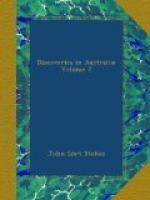From the masthead I got a tolerably good view of the island, in some places scarcely a cable wide, and a number of islets scattered to the north-west. The lagoon at this place was not more than three miles across, though marked twelve in the old charts; and I could trace the long line of white breakers rolling in on the other side in solemn grandeur, contrasting strongly in their foaming turbulence with the placid waters within the protection of the reef and island. I could clearly distinguish the limit of the danger in this direction, and that there was nothing to break the swell beyond. The surface of the lagoon was diversified by blue and grey patches, showing the alternations of shoal and deep water; near the centre there appeared to be a channel, which we afterwards found to be ten fathoms deep.
In the head of the bight where we were anchored, there was a narrow low sandy neck, placed by our observations in latitude 28 degrees 58 minutes 26 seconds South and longitude 1 degree 47 minutes 32 seconds west of Swan River,* over which we hauled a boat to examine the opposite side of the lagoon.
(Footnote. As we shall refer all longitudes during this cruise to Scott’s Jetty, Swan River, I may here state that the approximate longitude of that place is considered to be 115 degrees 47 minutes East of Greenwich.)
A few remarkable clumps of mangroves pointed out the position of some lagoons about a mile and a half from the south end of the island, which is fronted by a line of low overhanging cliffs of recent, cream-coloured limestone. Upon these rests a layer of a kind of soil, in some places eighteen inches deep, in others four feet, in which the seabirds burrow, and which, from what I have since seen of the much sought after guano, I believe to contain some of the valuable substance. In some of the islands forming Houtman’s Abrolhos which we subsequently examined, I found similar signs of the presence of this manure, which I think worthy of being made the subject of enquiry.
On the south part of the island I found a block of scoria measuring three feet by two; which, though not appearing to possess the power of floating, must have been brought by the current from the volcanic island of St. Paul’s. We saw a few hair-seals on the beach when we landed, and a rich kind of rock oyster was found at low-water.




